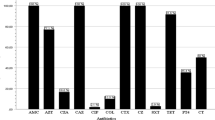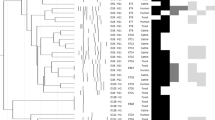Abstract
Certain subgroups of Escherichia coli have congenital or acquired virulence properties that allow them to cause a wide spectrum of disease. The aim of this study was to investigate the occurrence of diarrheagenic E. coli strains in ready-to-eat (RTE) foods produced in institutional, commercial and hotel restaurants in Salvador, Brazil. The presence of virulent isolates and antimicrobial resistance were evaluated. Four hundred forty-six samples were collected and grouped into cereals and vegetables, meat-based preparations, cooked salads, raw salads, garnishes, soups and sauces, desserts and juices. E. coli were detected using the most probable number method, the presence of virulence factors in isolates was determined by polymerase chain reaction (PCR) assays, and antibiotic resistance was analyzed using the disc diffusion method. In total, 15 isolates (3.1%) of E. coli were recovered; raw salads had the highest detection rate, 1.4%, followed by cooked salads, 0.8%; meat-based preparations, 0.4%; and cereals and vegetables, 0.4%. PCR assays showed that none of the isolates had the virulence genes cnf1, cnf2, eae, sta, lt1, stx1, stx2 or cdtB. The isolates showed resistance to nine antibiotics of the 15 tested, and the highest levels of resistance were found for sulfamethoxazole/trimethoprim, tetracycline, ampicillin, and chloramphenicol (13.3% of isolates for each antibiotic). One isolate from cooked salad had plasmid-mediated multidrug resistance to tetracycline, trimethoprim/sulfamethoxazole, ampicillin and chloramphenicol. These results suggest that RTE foods, especially raw salads, can be reservoirs of E. coli and facilitate the spread of antibiotic resistance genes to the gastrointestinal microbiota of humans.
Similar content being viewed by others
References
APHA (2001) Compendium of methods for the microbiological examination of foods, 4th edn. American Public Health Association, Washington, D.C
Barros MR, Silveira WD, Araújo JM, Costa EP, Oliveira AAF, Santos APSF et al (2012) Resistência antimicrobiana e perfil plasmidial de Escherichia coli isolada de frangos de corte e poedeiras comerciais no Estado de Pernambuco. Pesq Vet Bras 32:405–410
Bautista-De Léon H, Gómez-Aldapa CA, Rangel-Vargas E, Vázquez-Barrios E, Castro-Rosas J (2013) Frequency of indicator bacteria, Salmonella and diarrheagenic Escherichia coli pathotypes on ready-to-eat cooked vegetable salads from Mexican restaurants. Lett Appl Microbiol 56:414–420. doi:10.1111/lam.12063
Blanco M, Blanco JE, Blanco J, Alonso MP, Balsalobre C, Mouriño M et al (1996) Polymerase chain reaction for detection of Escherichia coli strains producing cytotoxic necrotizing factor type 1 and type 2 (CNFl and CNF2). J Microbiol Methods 26:95–101
Brasil (2001) Ministério da Saúde, Brasil. Resolução RDC no 12, de 02 de janeiro de 2001. http://portal.anvisa.gov.br/wps/wcm/connect/a47bab8047458b909541d53fbc4c6735/RDC_12_2001.pdf?MOD=AJPERES. Accessed 26 Feb 2016
Brasil (2016) Ministério da Saúde, Brasil. Doenças transmitidas por alimentos. http://portalsaude.saude.gov.br/images/pdf/2016/marco/10/Apresenta-dados-gerais-DTA-2016.pdf. Accessed 15 Mar 2016
Campos J, Mourão J, Pestana N, Peixe L, Novais C, Antunes P (2013) Microbiological quality of ready-to-eat salads: an underestimated vehicle of bacteria and clinically relevant antibiotic resistance genes. Int J Food Microbiol 166:464–470. doi:10.1016/j.ijfoodmicro.2013.08.005
Canizalez-Roman A, Gonzalez-Nuñez E, Vidal JE, Flores-Villaseñor H, Léon-Sicairos N (2013) Prevalence and antibiotic resistance profiles of diarrheagenic Escherichia coli strains isolated from food items in northwestern Mexico. Int J Food Microbiol 164:36–45. doi:10.1016/j.ijfoodmicro.2013.03.020
CDC (2012) Pathogens causing US foodborne illnesses, hospitalizations, and deaths, 2000–2008. http://www.cdc.gov/foodborneburden/pdfs/pathogens-complete-list-04-12.pdf. Accessed 18 Jan 2016
CLSI (2013) Performance standards for antimicrobial susceptibility testing; twenty-third informational supplement. Clinical and Laboratory Standards Institute
Gómez-Aldapa CA, Rangel-Vargas E, Castro-Rosas J (2013) Frequency and correlation of some enteric indicator bacteria and Salmonella in ready-to-eat raw vegetable salads from Mexican restaurants. J Food Sci 78:M1201–M1207. doi:10.1111/1750-3841.12182
Jeffrey L, Gurtler JB, Stawick BA (2001) Enterobacteriaceae, coliforms, and Escherichia coli as quality and safety indicators. In: Downes FP, Ito K (eds) Compendium of methods for the microbiological examination of foods, 4th edn. American Public Health Association, Washington, pp 69–82
Jiang X, Yu T, Wu N, Meng H, Shi L (2014) Detection of qnr, aac (6′)-Ib-cr and qepA genes in Escherichia coli isolated from cooked meat products in Henan, China. Int J Food Microbiol 187:22–25. doi:10.1016/j.ijfoodmicro.2014.06.026
Kaper JB, Nataro JP, Mobley HLT (2004) Pathogenic Escherichia coli. Nat Rev 2:123–140. doi:10.1038/nrmicro818
Krumperman PH (1983) Multiple antibiotic resistance indexing of Escherichia coli to identify high-risk sources of fecal contamination of foods. Appl Environ Microbiol 46:165–170
Li R, Tan X, Xiao J, Wang H, Liu Z, Zhou M, Bi W, Miyamoto T (2016) Molecular screening and characterization of Shiga toxin-producing Escherichia coli in retail foods. Food Control 60:180–188. doi:10.1016/j.foodcont.2015.07.045
Min SC, Roh SH, Niemira BA, Boyd G, Sites JE, Uknalis J, Fan X (2017) In-package inhibition of E. coli O157:H7 on bulk Romaine lettuce using cold plasma. Food Microbiol 65:1–6. doi:10.1016/j.fm.2017.01.010
Molina-Aja A, Garcia-Gasca A, Abreu-Grobois A, Bolán-Mejía C, Roque A, Gomez-Gil B (2002) Plasmid profiling and antibiotic resistance of Vibrio strains isolated from cultured penaeid shrimp. FEMS Microbiol Lett 213:7–12
Newell DG, Koopmans M, Verhoef L, Duizer E, Aidara-Kane A, Sprong H et al (2010) Food-borne diseases—the challenges of 20 years ago still persist while new ones continue to emerge. Int J Food Microbiol 139:S3–S15. doi:10.1016/j.ijfoodmicro.2010.01.021
Ojeniyi B, Ahrens P, Meyling A (1994) Detection of fimbrial and toxin genes in Escherichia coli and their prevalence with piglets with diarrhea: the application of colony hybridization assay polymerase chain reaction and phenotype assays. J Vet Med 41:49–59
Olaimat AN, Holley RA (2012) Factors influencing the microbial safety of fresh produce: a review. Food Microbiol 32:1–19. doi:10.1016/j.fm.2012.04.016
Olsvik O, Strockbine NA (1993) PCR detection of heat-stable, and Shiga-like toxin genes in Escherichia coli. In: Persing DH, Smith TF, Tenover FC, White TJ (eds) Diagnostic molecular microbiology. American Society for Microbiology, Washington, pp 271–276
Orskov I, Orskov F, Rowe B (1984) Six new E. coli O groups: O165, O166, O167, O168, O169 and O170. Acta Pathologica, Microbiologica, et Immunologica Scandinavica. Section B 92:189–193
Peresi JTM, Almeida IAZC, Vaz TMI, Hernandez RT, Teixeira ISC, Silva SIL et al (2016) Search for diarrheagenic Escherichia coli in raw kibbe samples reveals the resence of Shiga toxin-producing strains. Food Control 63:165–170. doi:10.1016/j.foodcont.2015.11.018
Ryu S, Lee J, Park S, Song M, Park S, Jung H et al (2012) Antimicrobial resistance profiles among Escherichia coli strains isolated from commercial and cooked foods. Int J Food Microbiol 159:263–266. doi:10.1016/j.ijfoodmicro.2011.10.003
Schultsz C, Pool GJ, Ketel R, Wever B, Speelman P, Dankert J (1994) Detection of enterotoxigenic Escherichia coli in stool samples by using nonradioactively labeled oligonucleotide DNA probes and PCR. J Clin Microbiol 32:2393–2397
Silva AS, Leite DS (2002) Investigation of putative CDT gene in Escherichia coli isolates from pigs with diarrhea. Vet Microbiol 89:195–199
Silva GJ, Mendonça N (2012) Association between antimicrobial resistance and virulence in Escherichia coli. Virulence 3:18–28. doi:10.4161/viru.3.1.18382
Siqueira AK, Ribeiro MG, Leite DS, Tiba MR, Moura C, Lopes MD et al (2009) Virulence factors in Escherichia coli strains isolated from urinary tract infection and pyometra cases and from feces of healthy dogs. Res Vet Sci 86:206–210. doi:10.1016/j.rvsc.2008.07.018
Sospedra I, Rubert J, Soriano JM, Mañes J (2013) Survey of microbial quality of plant-based foods served in restaurants. Food Control 30:418–422. doi:10.1016/j.foodcont.2012.08.004
Taban BM, Halkman AK (2011) Do leafy green vegetables and their ready-to-eat (RTE) salads carry a risk of foodborne pathogens? Anaerobe 17:286–287. doi:10.1016/j.anaerobe.2011.04.004
WHO (2015) Food safety. http://www.who.int/mediacentre/factsheets/fs399/en/. Accessed 1 Mar 2016
Whyte P, McGill K, Monahan C, Collins JD (2004) The effect of sampling time on the levels of microorganisms recovered from broiler carcasses in a commercial slaughter plant. Food Microbiol 21:59–65. doi:10.1016/S0740-0020(03)00040-6
Yang S, Pei X, Wang G, Yan L, Hu J, Li Y et al (2016) Prevalence of food-borne pathogens in ready-to-eat meat products in seven different Chinese regions. Food Control 65:92–98. doi:10.1016/j.foodcont.2016.01.009
Yu J, Kaper JB (1992) Cloning and characterization of the eae gene of enterohaemorragic Escherichia coli O157:H7. Mol Microbiol 6:411–417
Acknowledgements
The authors thank the technical team of the Food Microbiology Laboratory and Dr. Alaise Gil Guimarães of the Federal University of Bahia, and Dr. Tomomasa Yano of the Campinas University, for their support during the research.
Author information
Authors and Affiliations
Corresponding author
Ethics declarations
Conflict of interest
The authors declares that they have no conflict of interest.
Rights and permissions
About this article
Cite this article
Lima, C.M., Souza, I.E.G.L., dos Santos Alves, T. et al. Antimicrobial resistance in diarrheagenic Escherichia coli from ready-to-eat foods. J Food Sci Technol 54, 3612–3619 (2017). https://doi.org/10.1007/s13197-017-2820-4
Revised:
Accepted:
Published:
Issue Date:
DOI: https://doi.org/10.1007/s13197-017-2820-4




